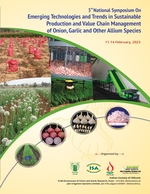Storage
Onion is an important commodity required throughout the year. So, storage of onion bulbs is essential for round the year supply. The bulbs harvested from Rabi season have better storage life than Kharif and late Kharif onion. The storage life of onion depends on various parameters like season, variety, bulb dormancy, nutrient and irrigation management, pest and disease incidence, pre-and post-harvest management practices and storage environment. Normally, light red onions varieties such as N-2-4-1, Bhima Kiran, Bhima Shakti, Arka Niketan and Agrifound Light Red are having more storage potential than dark red, white and yellow varieties. Field curing should be done till the foliage turns yellow and necks become thin followed by a shade curing with adequate ventilation. Shade curing of bulbs protects the bulbs from sun scalding, improves the bulb colour and keeps the outer surface scale dry. Excessive exposure to sunlight also causes sloughing of the outer scales (baldness), sunburn and excessive shrinkage of the onion. Medium size bulbs (50-80 mm) free from cuts and bruises are recommended for storage.
Bulbs need to be stored in 40-50 kg jute (hessian) bags, gunny bags, plastic netted bags or plastic and wooden baskets for better storage. Most of the farmers are using plastic/nylon netted bags for domestic as well as export purpose because these bags are more economical, easily available and attractive. After packing, onion bulbs should be stacked in a storage structure up to 5 feet height for easy handling. DOGR has developed different types of storage structures for storing onion bulbs. Bottom and side ventilated two-row storage structure and low cost bottom ventilated single row storage structure have been recommended. The optimum conditions for storage are 30-35˚C and 65-70% relative humidity under ambient condition.
Storage of onion bulbs in cold store with optimum relative humidity extends shelf life of onion bulbs and reduces post-harvest storage losses. Optimal storage temperature in cold storage is 0°C with 65-70% relative humidity. Under these conditions, the storage losses after six months are only about 5% which is mainly due to moisture loss. Regular monitoring of both temperature and relative humidity in the store are necessary to avoid significant fluctuations in environmental conditions. Very low temperature (<-2°C) may lead to freezing injury and high temperature (2- 25°C) coupled with high relative humidity (>75%) may cause rotting. The use of gamma irradiation (cobalt 60) at 60 Gr. controls the sprouting completely. However, gradual decrease in temperature i.e. preconditioning, before taking out commodity from cold store is essential to reduce microbial decay.
|
 |
 |
|
Bottom and side ventilated two-row storage structure |
Low cost bottom and side ventilated single row storage structure |















